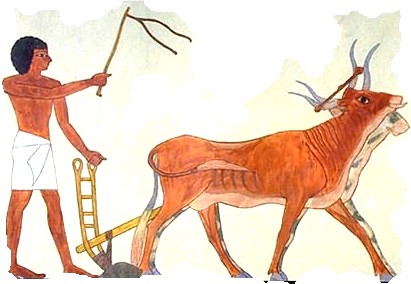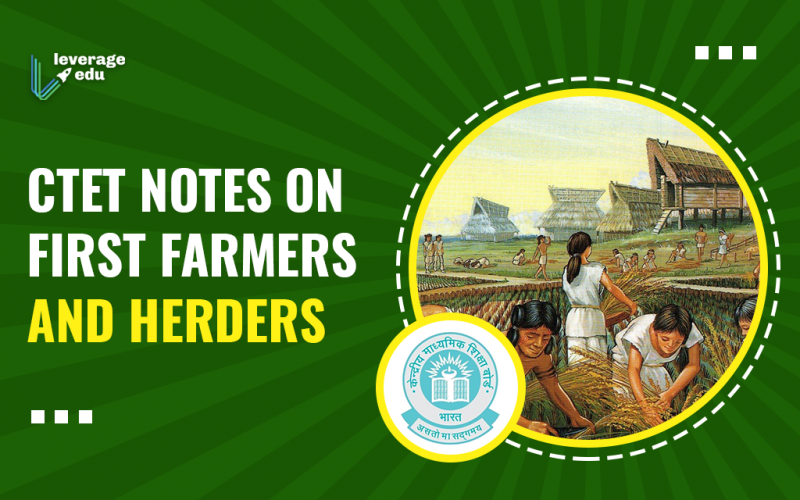Every day, we consume bread, roti, veggies, dal, fruits, and other types of food items. Have you ever considered how humans discovered food? Which fruits and vegetables were safe to eat, and which were dangerous? Do you know that humans used to harvest edible goods from nature before we started farming food? Let’s look back in time to see how we progressed from gathering to growing food. This blog will cover all the significant details of the CTET Notes on First Farmers and Herders for the CTET exam!
Explore: CTET Notes and Study Plan
Table of contents
How did Farming and Herding Start?
The New Stone Age began some 10,000 years ago. This was also recognized as the human race’s age of greatest progress. During this time, humans transitioned from gathering to growing food, as well as breeding and herding animals. Moving forward on CTET Notes on first farmers and herders, we will see how farming and herding start. Have a look:
- The planet began to warm approximately 12,000 years ago. Plants, trees, grasslands, and overall greenery increased as a result of this. As a result, grass-eating animals such as deer, goats, sheep, and others began to multiply.
- Humans were still gatherers, gathering only what they could consume. As the amount of greenery rose, people began to notice the locations where food plants might be found, as well as how seeds broke off stalks, fell to the ground, and produced new plants.
- Animals began to flock to areas where people planted crops to eat the grass. People began to allow non-aggressive animals, such as sheep and goats, to come and stay near them because these animals provided milk, meat, and in some cases, even carried a weight.
- These animals would be attacked by wild animals looking for food. Humans, on the other hand, began to protect them against these attacks and gradually became herders. A dog was the first animal that man domesticated.

Read: CTET Syllabus
A New Way of Life: From Gathering to Growing Food
We saw how farming and herding started in the previous section. In the next section of CTET Notes on first farmers and herders, now we will learn the new ways that were adopted by people which encouraged them to start growing food.
- When humans first began farming, they discovered that seeds took days, weeks, months, and even years to grow. This required people to stay in one spot for an extended period of time in order to care for the plants, water them, and protect them from birds and animals.
- People gradually began to make clay pots or woven baskets, and some even dug storage pits in the earth.
- Animals served as a food resource since they provided people with milk and meat. People settled down in one place for longer periods of time as a result of this transition. The man began to plant roots as he switched from gathering to cultivating food.
Also Read: CTET Notes on Health and Diseases
Archaeological Findings
Early farmers and herders have been discovered by archaeologists in various regions such as Mehrgarh, Chirand, Daojali Hading, Hallur, Paiyampalli, Koldihwa, and many more. Grain and bones were also discovered in several locations around the globe. It was proof of a period when man transitioned from gathering to growing food.
Below is a basic overview of where grains and bones were discovered:
| Grains and Bones | Sites |
| Wheat, Barley, Sheep, Goat & Cattle | Mehrgarh (in present day-Pakistan) |
| Rice & fragmented animal bones | Koldihwa (in present-day Uttar Pradesh) |
| Rice & cattle (hoof marks on clay surface) | Mahagara (in present-day Uttar Pradesh) |
| Lentil & Wheat | Gufkral (in present-day Kashmir) |
| Wheat, lentil, dog, cattle & sheep | Burzahom (in present-day Kashmir) |
Archaeologists discovered pit-houses constructed into the ground with steps going into them, as well as cooking utensils inside and outside the homes, in Burzahom. Many more tools were discovered, including those with a polished edge to aid in cutting and mortars and pestles to aid in grinding. Earthen pots were discovered in several locations, which were used for both storage and cooking.
Related Read: CTET Notes on Learning Principles and Theories
Mehrgarh
In the next section of CTET Notes on First farmers and herders, let’s take a deeper look at two locations where archaeologists discovered early farmers and herders: Mehrgarh and Daojali Hading:
- The earliest known civilization on the subcontinent was in Mehrgarh (now in Pakistan). This occurred near the Bolan Pass, which is a crucial section of the route to Iran. Archaeologists discovered many burned grains and animal bones during their excavations.
- Other investigations turned up the remains of square or rectangular dwellings with four or more compartments – a storage-friendly design. There were also some burial sites discovered.
- Archeologists came to the conclusion that Mehrgarh was one of the earliest villages known to us as a result of their excavations. Mehrgarh was likely one of the first areas where humans began to cultivate wheat and barley and raise livestock.
Daojali Hading
- Daojali Hading is located in the highlands surrounding the Brahmaputra river, close to the routes leading into China and Myanmar (Burma) (in Assam). Archaeologists discovered stone tools such as a mortar and pestle during their excavations in this location.
- This indicated that individuals could be able to grow and prepare food for consumption. Aside from these, various tools made of fossil wood (wood that has hardened into stone) and ceramics, as well as Jadeite – a stone that may have been transported from China – were discovered.
Explore: CTET Child Development Theories
FAQs
Archaeologists have found proof of early farmers and headers from sites such as Burzahom, Koldihwa, Daojali Hading, Mehrgarh, etc.
Sir Albert Howard, the British Botanist is recognised as the father of modern organic agriculture.
The era of new stone age (10,000 years ago) is known as the period of great development for the human race. During this time human beings shifted from gathering food to growing food and herd animals.
The most common route into the prestigious profession of teaching is through the Central Teaching Eligibility Test (CTET). If you’re taking the CTET exam this year, check out our blog for CTET notes, study plans, and other helpful hints. We hope the content provided for the CTET Notes on First Farmers and Herders was useful to you. For more educational content, follow the study abroad experts at Leverage Edu on Facebook, Youtube, Instagram.

 One app for all your study abroad needs
One app for all your study abroad needs























 45,000+ students trusted us with their dreams. Take the first step today!
45,000+ students trusted us with their dreams. Take the first step today!


